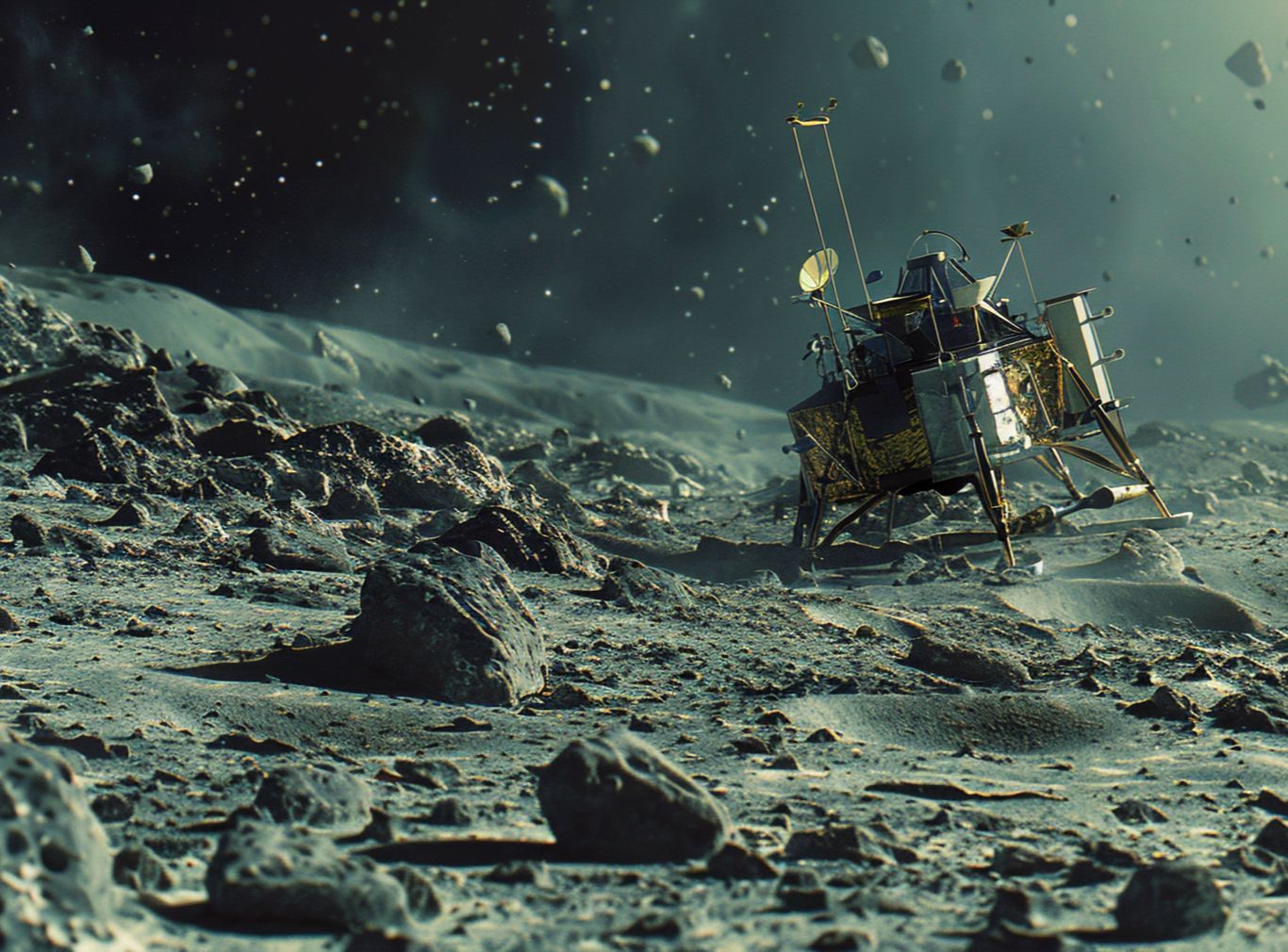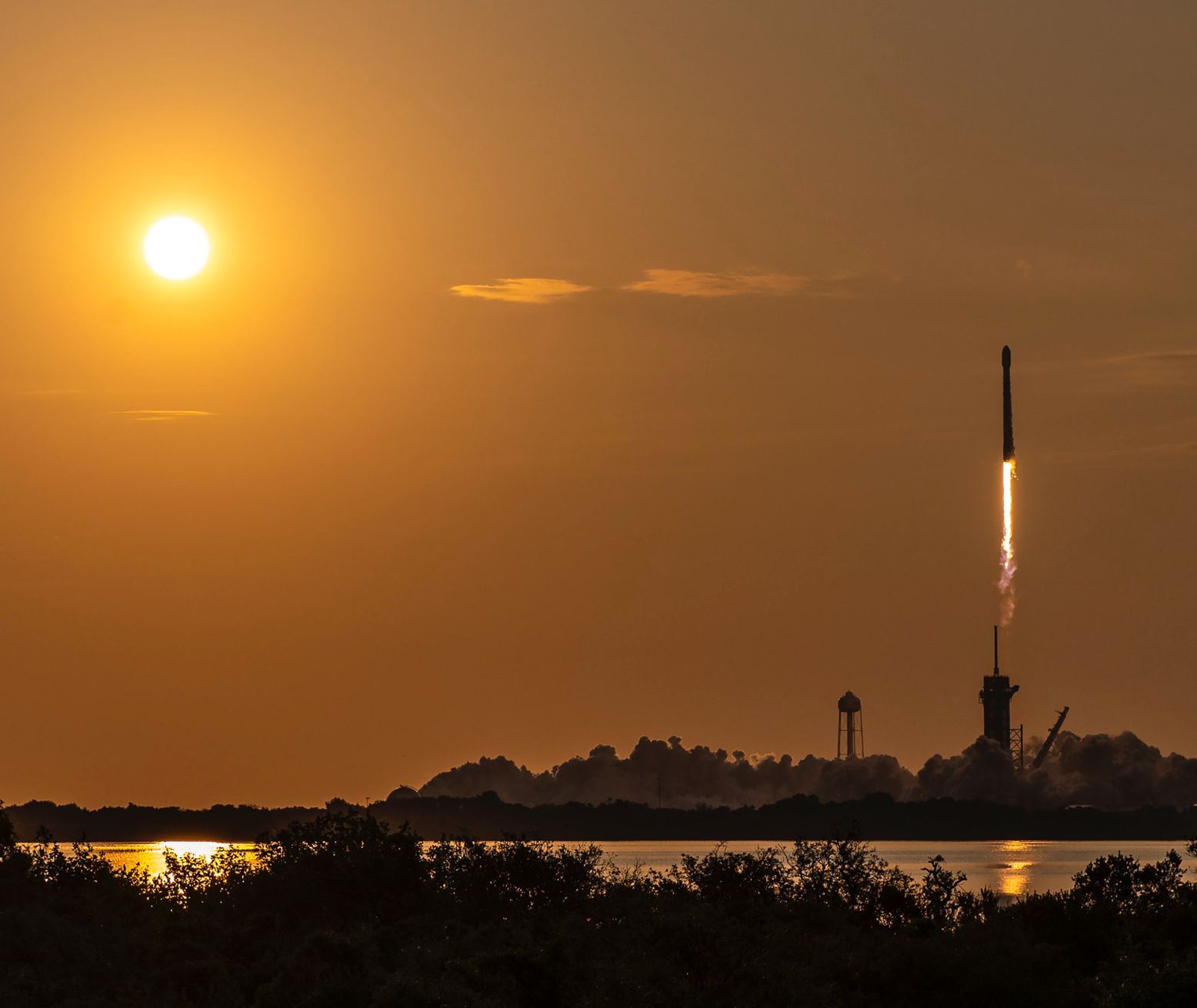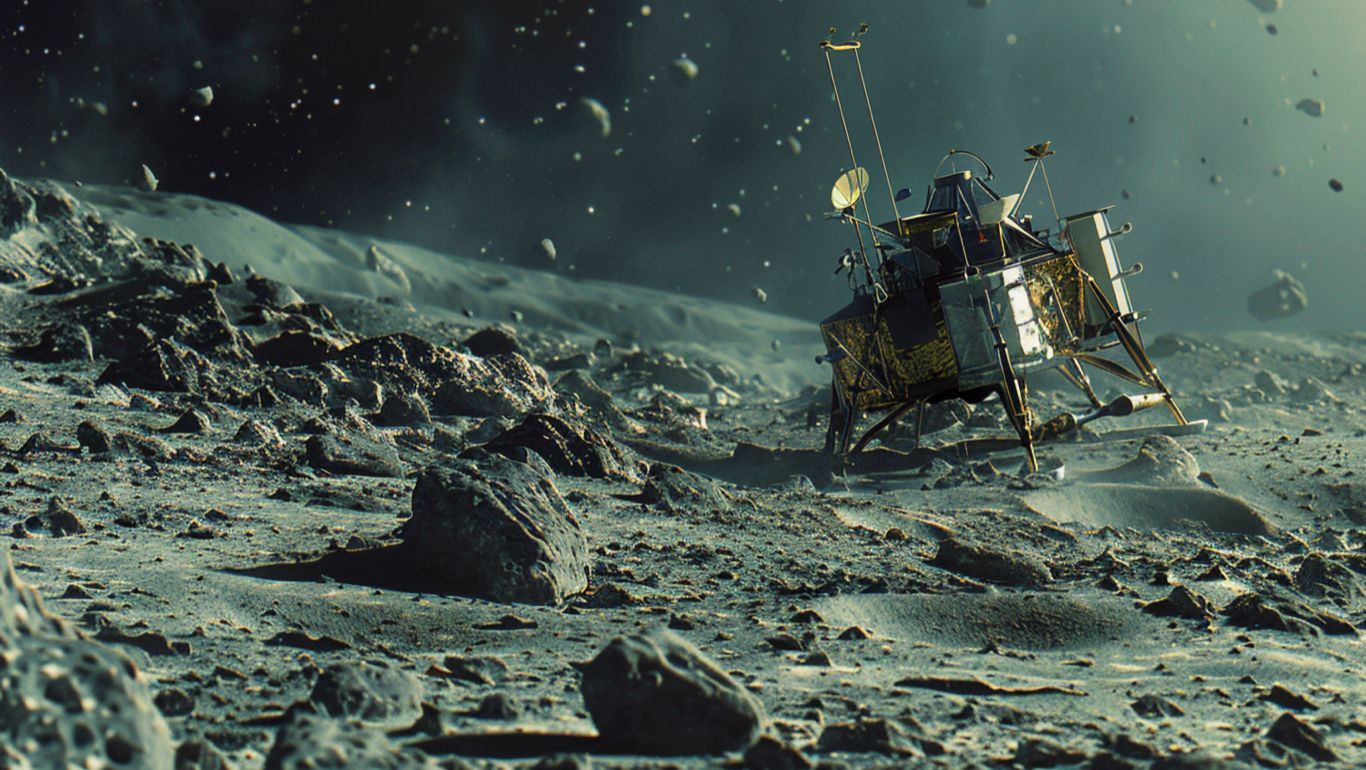Define Our Future
10 May 2024

(Image: SpaceX)
"Space is limitless and infinite, and so is the business associated with it," said Kam Ghaffarian, co-founder of the lunar exploration company Intuitive Machines. He was speaking in reference to the anticipated second lunar mission from the company later this year. However, something similar could be said about Earth's orbit. While the commercial satellite market has been expanding rapidly in the previous decade, opportunities for downstream and in-space services seem set for continued growth as companies expand the possibilities of commercial satellite technology.
According to a new report from Quilty Space, SpaceX’s Starlink broadband mega-constellation is set to record a $6.6 billion turnover for 2024, a remarkable jump from $1.4 billion in 2022. While SpaceX can attribute this growth to lowering the cost of manufacturing their own satellites and reducing reliance on outside suppliers, they also have a growing subscriber base. In an article via Space News, Starlink now has "roughly 50,000 mobility, enterprise, and government users, excluding those supporting Ukraine.”
Starlink will be rivalled by Amazon’s Kuiper constellation, as well as China’s Gauging and Starlink G60 constellations in the near future, so the internet connectivity market seems set to continue to expand. However, other sectors also continue to benefit from satellite services and downstream data.
California-based startup Muon Space is developing its own small satellites aimed at preventing wildfires, in cooperation with the nonprofit Earth Fire Alliance. Their FireSats use infrared sensors to quickly detect fires, allowing for fast response times, and help to provide firefighting services with accurate information relating to size and location. They expect their first satellites to launch in 2026.
Another California-based company, Xona Space Systems, has this week raised $19 million toward the development of their low Earth orbit (LEO) satellite network to provide navigation services. They claim that their Pulsar satellites can provide more precise navigation than GPS and also provide alternative options should GPS fail or be attacked by adversaries.
Commercial satellite technology is providing advantages for a wider scope of users in sectors ranging from navigation, Earth observation, agriculture, and finance, brought about by increased and cost-effective access to space.
Is there a danger of over-reliance on commercial space tech?
The defence sector is also recognising the need to access this technology, with SpaceX developing Starshield, a version of Starlink enabled for defence customers. Additionally, the US Space Force is tasking commercial entities with providing responsive space technology to be used during times of conflict, such as the Victus Nox rapid satellite launch demo from Firefly Aerospace last year.
However, Stacey Dixon, U.S. deputy director of national intelligence, said this week that while US (and perhaps others) commercial tech is providing many innovative solutions, much is being lost to adversaries because they "aren’t properly protecting it." This technology could be purchased directly or indirectly on the market, and concerns have been raised about Russian use of Starlink in Ukraine in this manner.
Speaking at the 2024 GEOINT Symposium, Dixon reiterated the need to improve cybersecurity measures and protect technology secrets from being stolen, warning that "...people are going to try to steal your secrets."

(Image: Adobe)
UN discusses Russia’s rejection of draft to prevent arms on space
This warning comes amid heightening concern regarding the militarisation of Earth orbit, with the UN Security Council failing to adopt a draft resolution put forward by Japan and the US, which called on "all States, in particular those with major space capabilities, to contribute actively to the objective of the peaceful use of outer space and the prevention of an arms race in outer space." Russia rejected the proposal, and China abstained.
This week, the General Assembly discussed the matter, with the president of the assembly, Dennis Francis, reiterating that "outer space does not belong to individual nations. Its peaceful and sustainable use is not subject to national appropriation and must be a place of peace and cooperation for the benefit and in the interest of all countries." He also reminded members that the Outer Space Treaty (OST) already prohibits the stationing of nuclear weapons or other weapons of mass destruction in space, a treaty that is signed and ratified by all the leading space nations.
Russian Ambassador and Permanent Representative, Vassily Nebenzia, explained their decision, stating that the title of the draft was "beautiful sounding" but did not properly explain the goal, considering the matter is already covered in the OST, and criticised it for attempting to introduce new proposals without proper discussion.
The representative of Iran, Hassan Rahimi Majd, went on to accuse the US of viewing space as a new arena of conflict, saying that they view "outer space as a potential battleground, as evidenced by the establishment of the Space Force and Space Command, and the integration of commercial space enterprises into their space combat systems.”
There is genuine concern about the weaponisation of Earth orbit, especially considering the risk of geopolitical tensions expanding into space. Furthermore, while the commercial sector is driving innovation in the sector, it is also seen by some as proliferation of the weaponisation of conflict in space.

(Image: Adobe)
China mission enters lunar orbit amid Space Race 2.0, use of lunar “safety zones” again discussed
There is also the risk that these conflicts could be dragged into outer space and onto the Moon, with a new space race unfolding between the US and China. In an op-ed article for Space News this week, Michelle Hanlon, the Executive Director of the Center for Air and Space Law at the University of Mississippi School of Law, discussed the race to secure areas of the Moon. Despite the fact that the OST clearly states that "a nation may not claim territory in space by any means.” Hanlon points out that there is an aspect of "due regard" in the OST, and this is clearly true in relation to the provision to avoid harmful interference.
Interference could be caused by vehicles or spacecraft landing on the Moon, spreading extremely harmful and destructive fine lunar soil plumes. As such, the US Artemis Accords call for the use of a "safety zone" around an active site on the Moon, which in theory could also be used to secure resource-rich areas on the lunar surface. The issue was also discussed during a US House Committee discussion last November, with Hanlon then suggesting that "winning only requires getting there first," and that even a crashed lander on the Moon would invoke the need for a safety zone and thus securing the resources within it.
All of this amounts to a growing "race mentality," beyond only Earth orbit, with commercial entities also being harnessed to build and maintain a lead. US private companies Astrobotic and Intuitive Machines launched their first missions to the Moon this year, with the latter becoming the first commercial entity to safely land on the surface. Both may also hope to launch their second missions towards the end of the year, carrying payloads to hunt for ice, a critical resource for establishing a sustained lunar presence.
Additionally, Firefly Aerospace hope to launch their inaugural Blue Ghost lunar lander this year, also contracted by NASA, looking to "advance lunar research and enable a sustainable presence on the Moon" (Firefly).
China close-in on lunar far-side
Most recently, China launched their Chang’e-6 lunar mission, tasked with returning regolith samples from the far-side of the Moon. After launching on May 3rd, it this week entered lunar orbit in preparation for descent. Once landed, sampling is to be completed within 48 hours, then returning to an orbiting vehicle and back to Earth in a reentry vehicle. The mission comes before their Chang’e-7 and 8 missions due to launch before the end of the decade, and will play a vital role in developing their own International Lunar Research Station (ILRS) in the 2030s.
These missions are laying the groundwork for the next steps in humankind’s journey into outer space, and from the US perspective, it’s the commercial sector which is taking them there. On the Moon, opportunities may be plentiful, but resources are not limitless. Businesses may see the vast opportunities that await, but must also be aware of what role they might play in this new race. Instead of proliferating this race, and while governments entangle themselves in geopolitical tensions, they could instead use lunar exploration as a means of building new partnerships, and mobilise the commercial sector as a force for good.
Define Our Future

(Image: SpaceX)
10 May 2024
Growing Dependence on Commercial Space Technology, UN Discuss Russia's Rejection of Draft on Space Arms Control - Space News Roundup

"Space is limitless and infinite, and so is the business associated with it," said Kam Ghaffarian, co-founder of the lunar exploration company Intuitive Machines. He was speaking in reference to the anticipated second lunar mission from the company later this year. However, something similar could be said about Earth's orbit. While the commercial satellite market has been expanding rapidly in the previous decade, opportunities for downstream and in-space services seem set for continued growth as companies expand the possibilities of commercial satellite technology.
According to a new report from Quilty Space, SpaceX’s Starlink broadband mega-constellation is set to record a $6.6 billion turnover for 2024, a remarkable jump from $1.4 billion in 2022. While SpaceX can attribute this growth to lowering the cost of manufacturing their own satellites and reducing reliance on outside suppliers, they also have a growing subscriber base. In an article via Space News, Starlink now has "roughly 50,000 mobility, enterprise, and government users, excluding those supporting Ukraine.”
Starlink will be rivalled by Amazon’s Kuiper constellation, as well as China’s Gauging and Starlink G60 constellations in the near future, so the internet connectivity market seems set to continue to expand. However, other sectors also continue to benefit from satellite services and downstream data.
California-based startup Muon Space is developing its own small satellites aimed at preventing wildfires, in cooperation with the nonprofit Earth Fire Alliance. Their FireSats use infrared sensors to quickly detect fires, allowing for fast response times, and help to provide firefighting services with accurate information relating to size and location. They expect their first satellites to launch in 2026.
Another California-based company, Xona Space Systems, has this week raised $19 million toward the development of their low Earth orbit (LEO) satellite network to provide navigation services. They claim that their Pulsar satellites can provide more precise navigation than GPS and also provide alternative options should GPS fail or be attacked by adversaries.
Commercial satellite technology is providing advantages for a wider scope of users in sectors ranging from navigation, Earth observation, agriculture, and finance, brought about by increased and cost-effective access to space.
Is there a danger of over-reliance on commercial space tech?
The defence sector is also recognising the need to access this technology, with SpaceX developing Starshield, a version of Starlink enabled for defence customers. Additionally, the US Space Force is tasking commercial entities with providing responsive space technology to be used during times of conflict, such as the Victus Nox rapid satellite launch demo from Firefly Aerospace last year.
However, Stacey Dixon, U.S. deputy director of national intelligence, said this week that while US (and perhaps others) commercial tech is providing many innovative solutions, much is being lost to adversaries because they "aren’t properly protecting it." This technology could be purchased directly or indirectly on the market, and concerns have been raised about Russian use of Starlink in Ukraine in this manner.
Speaking at the 2024 GEOINT Symposium, Dixon reiterated the need to improve cybersecurity measures and protect technology secrets from being stolen, warning that "...people are going to try to steal your secrets."

(Image: Adobe)
UN discusses Russia’s rejection of draft to prevent arms on space
This warning comes amid heightening concern regarding the militarisation of Earth orbit, with the UN Security Council failing to adopt a draft resolution put forward by Japan and the US, which called on "all States, in particular those with major space capabilities, to contribute actively to the objective of the peaceful use of outer space and the prevention of an arms race in outer space." Russia rejected the proposal, and China abstained.
This week, the General Assembly discussed the matter, with the president of the assembly, Dennis Francis, reiterating that "outer space does not belong to individual nations. Its peaceful and sustainable use is not subject to national appropriation and must be a place of peace and cooperation for the benefit and in the interest of all countries." He also reminded members that the Outer Space Treaty (OST) already prohibits the stationing of nuclear weapons or other weapons of mass destruction in space, a treaty that is signed and ratified by all the leading space nations.
Russian Ambassador and Permanent Representative, Vassily Nebenzia, explained their decision, stating that the title of the draft was "beautiful sounding" but did not properly explain the goal, considering the matter is already covered in the OST, and criticised it for attempting to introduce new proposals without proper discussion.
The representative of Iran, Hassan Rahimi Majd, went on to accuse the US of viewing space as a new arena of conflict, saying that they view "outer space as a potential battleground, as evidenced by the establishment of the Space Force and Space Command, and the integration of commercial space enterprises into their space combat systems.”
There is genuine concern about the weaponisation of Earth orbit, especially considering the risk of geopolitical tensions expanding into space. Furthermore, while the commercial sector is driving innovation in the sector, it is also seen by some as proliferation of the weaponisation of conflict in space.

(Image: Adobe)
China mission enters lunar orbit amid Space Race 2.0, use of lunar “safety zones” again discussed
There is also the risk that these conflicts could be dragged into outer space and onto the Moon, with a new space race unfolding between the US and China. In an op-ed article for Space News this week, Michelle Hanlon, the Executive Director of the Center for Air and Space Law at the University of Mississippi School of Law, discussed the race to secure areas of the Moon. Despite the fact that the OST clearly states that "a nation may not claim territory in space by any means.” Hanlon points out that there is an aspect of "due regard" in the OST, and this is clearly true in relation to the provision to avoid harmful interference.
Interference could be caused by vehicles or spacecraft landing on the Moon, spreading extremely harmful and destructive fine lunar soil plumes. As such, the US Artemis Accords call for the use of a "safety zone" around an active site on the Moon, which in theory could also be used to secure resource-rich areas on the lunar surface. The issue was also discussed during a US House Committee discussion last November, with Hanlon then suggesting that "winning only requires getting there first," and that even a crashed lander on the Moon would invoke the need for a safety zone and thus securing the resources within it.
All of this amounts to a growing "race mentality," beyond only Earth orbit, with commercial entities also being harnessed to build and maintain a lead. US private companies Astrobotic and Intuitive Machines launched their first missions to the Moon this year, with the latter becoming the first commercial entity to safely land on the surface. Both may also hope to launch their second missions towards the end of the year, carrying payloads to hunt for ice, a critical resource for establishing a sustained lunar presence.
Additionally, Firefly Aerospace hope to launch their inaugural Blue Ghost lunar lander this year, also contracted by NASA, looking to "advance lunar research and enable a sustainable presence on the Moon" (Firefly).
China close-in on lunar far-side
Most recently, China launched their Chang’e-6 lunar mission, tasked with returning regolith samples from the far-side of the Moon. After launching on May 3rd, it this week entered lunar orbit in preparation for descent. Once landed, sampling is to be completed within 48 hours, then returning to an orbiting vehicle and back to Earth in a reentry vehicle. The mission comes before their Chang’e-7 and 8 missions due to launch before the end of the decade, and will play a vital role in developing their own International Lunar Research Station (ILRS) in the 2030s.
These missions are laying the groundwork for the next steps in humankind’s journey into outer space, and from the US perspective, it’s the commercial sector which is taking them there. On the Moon, opportunities may be plentiful, but resources are not limitless. Businesses may see the vast opportunities that await, but must also be aware of what role they might play in this new race. Instead of proliferating this race, and while governments entangle themselves in geopolitical tensions, they could instead use lunar exploration as a means of building new partnerships, and mobilise the commercial sector as a force for good.
Share this article
10 May 2024
Growing Dependence on Commercial Space Technology, UN Discuss Russia's Rejection of Draft on Space Arms Control - Space News Roundup


(Image: SpaceX)
"Space is limitless and infinite, and so is the business associated with it," said Kam Ghaffarian, co-founder of the lunar exploration company Intuitive Machines. He was speaking in reference to the anticipated second lunar mission from the company later this year. However, something similar could be said about Earth's orbit. While the commercial satellite market has been expanding rapidly in the previous decade, opportunities for downstream and in-space services seem set for continued growth as companies expand the possibilities of commercial satellite technology.
According to a new report from Quilty Space, SpaceX’s Starlink broadband mega-constellation is set to record a $6.6 billion turnover for 2024, a remarkable jump from $1.4 billion in 2022. While SpaceX can attribute this growth to lowering the cost of manufacturing their own satellites and reducing reliance on outside suppliers, they also have a growing subscriber base. In an article via Space News, Starlink now has "roughly 50,000 mobility, enterprise, and government users, excluding those supporting Ukraine.”
Starlink will be rivalled by Amazon’s Kuiper constellation, as well as China’s Gauging and Starlink G60 constellations in the near future, so the internet connectivity market seems set to continue to expand. However, other sectors also continue to benefit from satellite services and downstream data.
California-based startup Muon Space is developing its own small satellites aimed at preventing wildfires, in cooperation with the nonprofit Earth Fire Alliance. Their FireSats use infrared sensors to quickly detect fires, allowing for fast response times, and help to provide firefighting services with accurate information relating to size and location. They expect their first satellites to launch in 2026.
Another California-based company, Xona Space Systems, has this week raised $19 million toward the development of their low Earth orbit (LEO) satellite network to provide navigation services. They claim that their Pulsar satellites can provide more precise navigation than GPS and also provide alternative options should GPS fail or be attacked by adversaries.
Commercial satellite technology is providing advantages for a wider scope of users in sectors ranging from navigation, Earth observation, agriculture, and finance, brought about by increased and cost-effective access to space.
Is there a danger of over-reliance on commercial space tech?
The defence sector is also recognising the need to access this technology, with SpaceX developing Starshield, a version of Starlink enabled for defence customers. Additionally, the US Space Force is tasking commercial entities with providing responsive space technology to be used during times of conflict, such as the Victus Nox rapid satellite launch demo from Firefly Aerospace last year.
However, Stacey Dixon, U.S. deputy director of national intelligence, said this week that while US (and perhaps others) commercial tech is providing many innovative solutions, much is being lost to adversaries because they "aren’t properly protecting it." This technology could be purchased directly or indirectly on the market, and concerns have been raised about Russian use of Starlink in Ukraine in this manner.
Speaking at the 2024 GEOINT Symposium, Dixon reiterated the need to improve cybersecurity measures and protect technology secrets from being stolen, warning that "...people are going to try to steal your secrets."

(Image: Adobe)
UN discusses Russia’s rejection of draft to prevent arms on space
This warning comes amid heightening concern regarding the militarisation of Earth orbit, with the UN Security Council failing to adopt a draft resolution put forward by Japan and the US, which called on "all States, in particular those with major space capabilities, to contribute actively to the objective of the peaceful use of outer space and the prevention of an arms race in outer space." Russia rejected the proposal, and China abstained.
This week, the General Assembly discussed the matter, with the president of the assembly, Dennis Francis, reiterating that "outer space does not belong to individual nations. Its peaceful and sustainable use is not subject to national appropriation and must be a place of peace and cooperation for the benefit and in the interest of all countries." He also reminded members that the Outer Space Treaty (OST) already prohibits the stationing of nuclear weapons or other weapons of mass destruction in space, a treaty that is signed and ratified by all the leading space nations.
Russian Ambassador and Permanent Representative, Vassily Nebenzia, explained their decision, stating that the title of the draft was "beautiful sounding" but did not properly explain the goal, considering the matter is already covered in the OST, and criticised it for attempting to introduce new proposals without proper discussion.
The representative of Iran, Hassan Rahimi Majd, went on to accuse the US of viewing space as a new arena of conflict, saying that they view "outer space as a potential battleground, as evidenced by the establishment of the Space Force and Space Command, and the integration of commercial space enterprises into their space combat systems.”
There is genuine concern about the weaponisation of Earth orbit, especially considering the risk of geopolitical tensions expanding into space. Furthermore, while the commercial sector is driving innovation in the sector, it is also seen by some as proliferation of the weaponisation of conflict in space.

(Image: Asdobe)
China mission enters lunar orbit amid Space Race 2.0, use of lunar “safety zones” again discussed
There is also the risk that these conflicts could be dragged into outer space and onto the Moon, with a new space race unfolding between the US and China. In an op-ed article for Space News this week, Michelle Hanlon, the Executive Director of the Center for Air and Space Law at the University of Mississippi School of Law, discussed the race to secure areas of the Moon. Despite the fact that the OST clearly states that "a nation may not claim territory in space by any means.” Hanlon points out that there is an aspect of "due regard" in the OST, and this is clearly true in relation to the provision to avoid harmful interference.
Interference could be caused by vehicles or spacecraft landing on the Moon, spreading extremely harmful and destructive fine lunar soil plumes. As such, the US Artemis Accords call for the use of a "safety zone" around an active site on the Moon, which in theory could also be used to secure resource-rich areas on the lunar surface. The issue was also discussed during a US House Committee discussion last November, with Hanlon then suggesting that "winning only requires getting there first," and that even a crashed lander on the Moon would invoke the need for a safety zone and thus securing the resources within it.
All of this amounts to a growing "race mentality," beyond only Earth orbit, with commercial entities also being harnessed to build and maintain a lead. US private companies Astrobotic and Intuitive Machines launched their first missions to the Moon this year, with the latter becoming the first commercial entity to safely land on the surface. Both may also hope to launch their second missions towards the end of the year, carrying payloads to hunt for ice, a critical resource for establishing a sustained lunar presence.
Additionally, Firefly Aerospace hope to launch their inaugural Blue Ghost lunar lander this year, also contracted by NASA, looking to "advance lunar research and enable a sustainable presence on the Moon" (Firefly).
China close-in on lunar far-side
Most recently, China launched their Chang’e-6 lunar mission, tasked with returning regolith samples from the far-side of the Moon. After launching on May 3rd, it this week entered lunar orbit in preparation for descent. Once landed, sampling is to be completed within 48 hours, then returning to an orbiting vehicle and back to Earth in a reentry vehicle. The mission comes before their Chang’e-7 and 8 missions due to launch before the end of the decade, and will play a vital role in developing their own International Lunar Research Station (ILRS) in the 2030s.
These missions are laying the groundwork for the next steps in humankind’s journey into outer space, and from the US perspective, it’s the commercial sector which is taking them there. On the Moon, opportunities may be plentiful, but resources are not limitless. Businesses may see the vast opportunities that await, but must also be aware of what role they might play in this new race. Instead of proliferating this race, and while governments entangle themselves in geopolitical tensions, they could instead use lunar exploration as a means of building new partnerships, and mobilise the commercial sector as a force for good.
Share this article

